skip to main |
skip to sidebar
Events of Tuesday 25th April 2017
It was time to say 'goodbye' to our friends at Ko Dut and continue north. We drove to Thanbyuzayat where we stopped at a teashop before continuing to Khaikhami village and the nearby Khaikhami Yele Paya Pagoda, built out into the sea, already thronged with pilgrims by the time we arrived. There are reports on previous visits I've made to this very special pagoda in 2012, with Dr. Hla Tun in 2014 and again in 2015.

Khaikhami Yele Paya - 2017
Following the pagoda visit, we continued to Mudon Drop In Centre where the children were sitting on the floor waiting patiently for our arrival. Doctor Hla Tun talked to the children about our visit and the Distribution we were about to make and, as he often does, asked the children if they remembered seeing me on a previous visit. A remarkable number of hands shot up. The importance of long-term support for these projects, where children need and deserve assistance for a period of years cannot be over-emphasised. It's encouraging that the staff, too, remain the same year after year so these visits become a real meeting of friends.

Distribution at Mudon Drop In Centre.
After the 'Group Shot' outside the Drop In Centre with the children proudly displaying their new uniforms, we were invited to stay for refreshments, after which they kindly presented me with a longyi in a traditional Mon pattern.

A group shot at Mudon
They were keen to measure and fit the longyi so, having taken brief measurements, they set to on one of a number of Singer treadle sewing machines to hem the garment and fit the waist securing tape. On the slim frame of a typical Burmese woman, the simple garment is elegant and hangs well with a straight front 'pleat'. The seamstress was not entirely satisfied with the effect on my overweight frame, so I had to have a second fitting before they were happy. All of this occurred with much happy laughter and my lack of Myanmar language seemed unimportant. I left wearing my now correctly-fitting longyi.
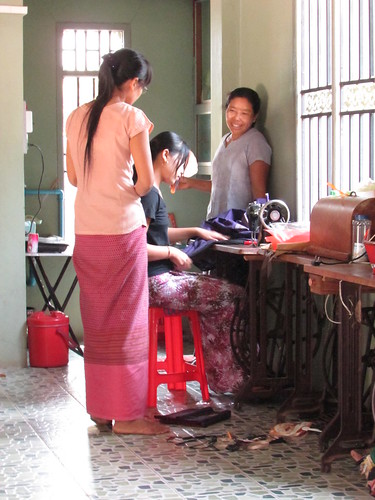
Mudon Drop In Centre - 2017: Longyi adjustments while-you-wait.
One of the local Drop In Centre staff on a moped then led the way for our driver to the next distribution at Ka Ma Wet Drop In Centre.

Ka Mar Wet Drop In Centre: Children waiting patiently for our arrival.
The Distribution proceeded as usual, including what now seemed to have become a regular feature of my being asked to address the children briefly in English, with translation by Doctor Hla Tun.
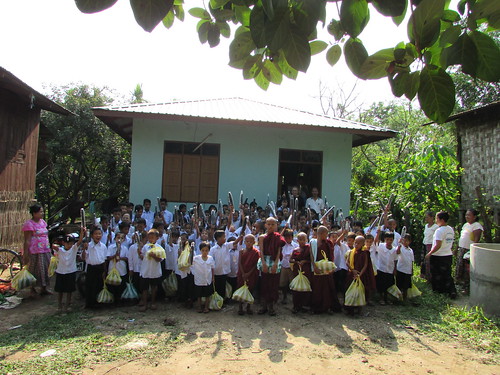
Ka Ma Wet Drop In Centre.
We then watched the happy children leave. Those from further away bundled onto a converted pick-up truck with seats and a motor-cycle taxi. These two types of vehicle provide the majority of local transport in Myanmar and the number of people who can be crammed aboard is remarkable. I think I counted nine children perched in the 'luggage rack' on the roof of the pick-up and I couldn't see how many inside.

Ka Mar Wet Drop In Centre: The heavily-loaded pick-up converted into taxi departs.
When the motor cycle taxi tried to leave, similarly overloaded, a small tree root across the dirt road in front of the vehicle almost prevented his departure!
Then it was our turn to depart and head for our appointment at Kot Kha Pon Drop In Centre where we repeated the distribution pattern. In some of the areas more prone to rain, folding umbrellas had been specifically requested so the children proudly held these aloft for the group photograph outside the Drop In Centre.
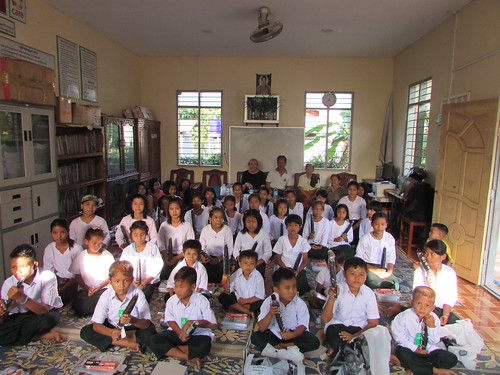
Kot Kha Pon Drop In Centre.
There was time for us to visit the 'Largest Reclining Buddha Image In The World' and the mausoleum of its founder at the Win Sein Taw Ya Pagoda. My visit to this amazing construction in 2012 is described here, then I returned in 2015 (described here and again in 2016 (described here.

The World's Largest Reclining Buddha.
Then we completed the journey to Mawlamyine, where the Doctor had arranged accommodation at the Kaung Myat Hotel.
I was delighted to discover that, apart from air conditioning and a bed with a thick mattress, there was Wi-Fi, so I declined the offer of an evening meal with Doctor Hla Tun and his mother and stayed in my room trying to deal with e-mails, after which I added an update to my blog.
Related Posts on this Website
Next Post describing this trip.
All 2017 Trip posts.
My Pictures
Where necessary, clicking on an image above will display an 'uncropped' view or, alternately, pictures from may be selected, viewed or downloaded, in various sizes, from the albums listed:-
Mudon Drop In Centre.
Ka Mar Wet Drop In Centre.
Kot Kha Pon Drop In Centre.
The World's Largest Reclining Buddha.
Kaung Myat Hotel, Mawlamyine.
All my albums for Burma 2017.
[Photos added and corrections to text: 16-Jul-2017]
Events of Monday 24th April 2017
Helpers from Ko Dut Drop In Centre arrived at our accommodation fairly early and, after preparing breakfast for the Doctor, the Doctor's mother and the writer, they lifted the large sacks of materials for the Distribution to Children from upstairs in the house to a waiting pick-up.
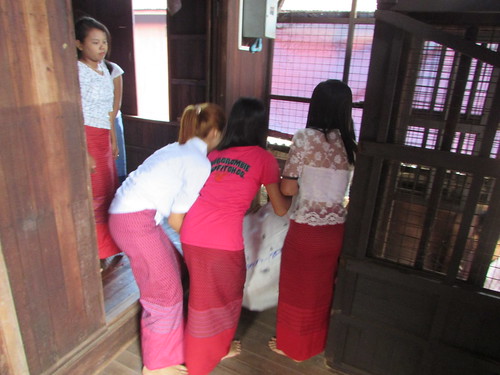
Around Ko Dut: Helpers from Ko Dut Drop In Centre moving the large sacks of materials for the Distribution to Children from upstairs in the house to a waiting pick-up.
With Ko Dut Drop In Centre temporarily unavailable, the monastery had agreed that the Assembly Hall there could be used for the distribution, so we arrived to find around 300 excited but surprisingly quiet young people sitting on the floor of the hall.

Distribution at Ko Dut Monastery.
Soon, a senior monk arrived, deputising for the abbott who had been called away. The senior monk sat facing the children together with a second monk. A simple portable amplification system with a radio microphone was set up.
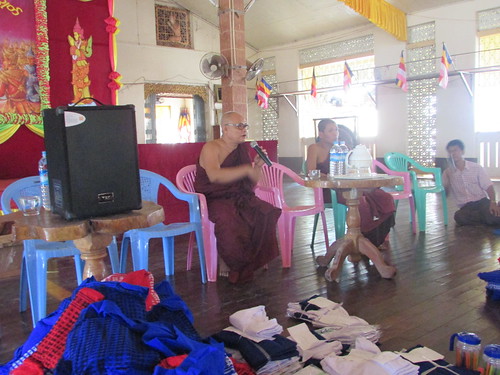
The Senior Monk at Ko Dut Monastery addresses the children.
After a brief exhortation by the Senior Monk, Doctor Hla Tun explained about the new donated school uniforms, school bags and stationery which was about to be distributed. The senior monk then suggested that I addressed the children. First, I would say a few sentences in English. Then I passed the microphone to Dr. Hla Tun who translated into standard Myanmar language. Then the microphone passed to one of the helpers, a fluent Mon speaker, to translate into the Mon language, as not all the children understood the standard Myanmar language. Then the microphone was returned to me, to say a little more.
The helpers from the Drop In Centre had prepared the donations by placing everything else in the new school bag so, as each child was called up, a helper passed the appropriate bag to me, and I presented it to the young scholar.
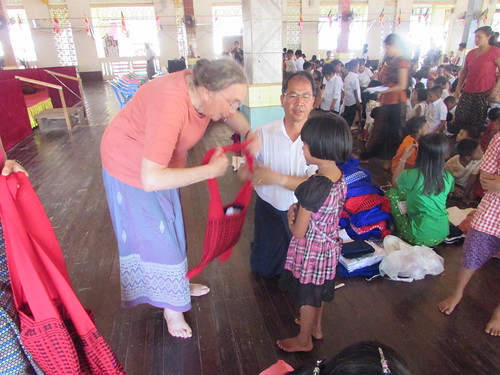
Distribution at Ko Dut Monastery.
Each child was then asked to put on the new uniform, with helpers giving assistance to the younger children, as necessary.
The work of presentation was not quite over. Each child then received a snack and soft drink which Jan assisted the helpers in distributing by moving among the seated children.

Snack and soft drink being given to children in their new uniforms.
Wearing their new uniforms, the students moved outside the assembly hall and sat in rows under a covered walkway for the 'group shot'. This took a few minutes as there were lots of cameras waiting to record the event. Someone then suggested that re-positioning everyone on nearby concrete steps would give a good effect, so all the children moved across and more pictures were taken.

Distribution at Ko Dut Monastery: The 'group shot'.
Doctor Hla Tun explained to me that the pupils we'd just seen came from seven schools in the area:-
Ko Dut Mon Ethnic School
Ko Dut Government Primary School
Ko Dut Government High School
Kot Cha Mon Ethnic School
Kot Cha Government School
Fel Gu School
Ku To Seik Mon Ethnic School.
We then drove to our final distribution of the day at the small Drop In Centre at Mot Ka Nin which I'd visited before. We were given the usual cordial greeting and all passed off smoothly.

Mok Ka Nin Drop In Centre.
Back in our car, we travelled back through La Mine to Ku To Seik Mon Ethnic School where various donations have been made in the past to assist in building completion. This was closed for the holidays but one of the teachers showed us around so that we could see the progress on the building.

Ku To Seik Mon Ethnic School.
I think I first visited Ku To Seik Mon Ethnic School in 2014 (as described here) and I returned in 2015 (as described here. This time, after inspecting the buildings, we didn't visit the nearby fishing village but instead returned to our accommodation in Ko Dut. I was relieved that the persistent drumbeat was not being played but the combination of heat, hard bed and my own joint pains meant that I still didn't get a very good night's sleep. During the night, there was a noisy thunderstorm then, after a delay, heavy, tropical rain for a while. By morning, there were only damp patches on the ground witnessing the earlier downpour.
Related Posts on this Website
Next post describing this trip.
All 2017 Trip posts.
My Pictures
Where necessary, clicking on an image above will display an 'uncropped' view or, alternately, pictures from may be selected, viewed or downloaded, in various sizes, from the albums listed:-
Around Ko Dut.
Distribution at Ko Dut Monastery.
Mot Ka Nin Drop In Centre.
All my albums for Burma 2017.
[Photos added to text and minor changes: 16-Jul-2017]
Events of Sunday 23rd April 2017
Fairly early, we loaded up the car and set off into the wooded hills. The road we took was narrow and twisting but, again, there was evidence of improvement work. At one point, a new reinforced concrete bridge was under construction. The stream being crossed was shallow enough that we were able to take a temporary route which forded the stream close by.
We passed an elderly carpenter working on the hull of a new wooden fishing boat so I realised we must be near a creek, which I spotted on our right. But I had not realised that the sea was close by on our left. As the road climbed a little, a beautiful white sand beach appeared on our left. The creek on our right opened out into a wide lake with a fleet of at least thirty sea-going, wooden-hulled fishing vessels moored.
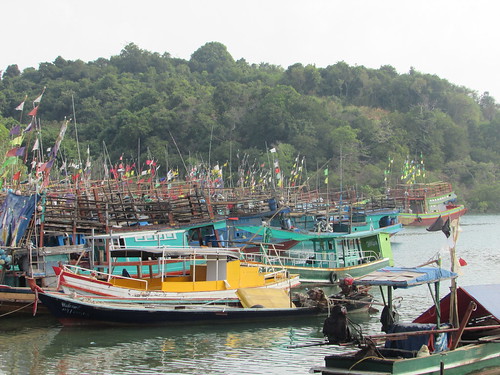
Trip to Myaw Tit Pagoda: Moored fishing fleet.
The fishing vessels looked very gay, each with a number of floats for their nets stored on deck because each float was topped with a bamboo flagpole carrying a number of differently-coloured pennants. This was very similar to the smaller fishing vessels I'd seen the previous year at the Mergui Archipelago (there's a series of posts describing this trip here).
We continued on a very rough, narrow track which terminated in a small car park surrounded by souvenir stalls overlooking the sea. From the car park, a concrete pedestrian causeway led to a small island with pagodas. We had arrived at Myaw Tit Pagoda. Because it was early in the day, there was only one coach carrying pilgrims in the car park and we were able to explore the location whilst it was still peaceful.
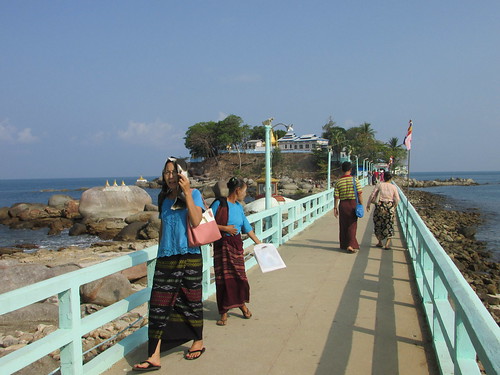
The Causeway leading to Myaw Tit Pagoda.
After our visit, we drove back to Dawei, passing a number of coaches and pick-up trucks taking more pilgrims to Myaw Tit.
In Dawei, we said goodbye to the Doctor's relative and the Doctor, the Doctor's Mother and I transferred to a shared-taxi people carrier together with our luggage and quite a number of other passengers, giving quite a cramped experience on the way north. This time, we passed through the mountain section and the road improvements in the daylight and work was in progress. Our driver chose to stop at a restaurant high in the hills to allow his passengers to take food. His chosen venue won my award for the dirtiest cafe I've seen in Myanmar (and that was against some pretty stiff competition). We stopped for immigration formalities as we passed from Tanintharyi Division back to Mon State. In daylight, the location looked less like a set for a spy film set in Berlin than it had when we passed through in the middle of the night in the opposite direction less than two days earlier!
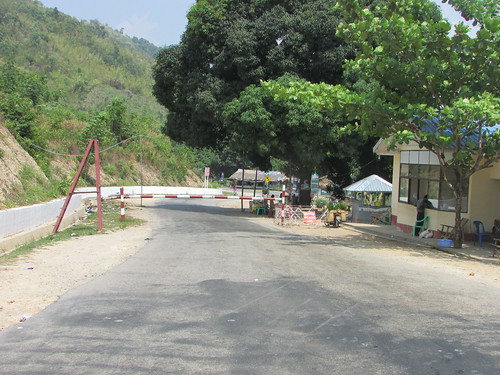
Returning North: The Border between Tanintharyi Division and Mon State.
We left the people carrier at a village on the main road north near to La Mine, together with some of the other passengers. I was delighted (and relieved) to see the lady who runs Ko Dut Drop In Centre, together with a car and driver. Having transferred all our luggage (again), we set off towards La Mine township.
About half an hour later, we pulled up at the small Drop In Centre of La Mine, which I'd visited before and most of the children there confirmed to the Doctor that they remembered my previous visits. The usual joyful proceedings followed as stationery and new school uniforms were distributed to the children. Attired in their new clothes, the children proudly posed for the 'group shot' on the steps of their Drop In Centre.
 La Mine Drop In Centre - 2017
La Mine Drop In Centre - 2017
Back in the car, we carried on through La Mine and took the road to Ko Dut. On the outskirts of Ko Dut, we stopped at the school which has been under construction during the last few years, as funds permitted. I was delighted to see that it is now in use, forming part of the Government's Basic Education system.
We arrived at Ko Dut Drop In Centre, which now stands next to an almost-complete Government Health Clinic. Construction of this clinic had also been protracted because of funding problems. I learnt that, this year, we would not be staying overnight at the Drop In Centre which had been temporarily closed for refurbishment following use as dormitory accommodation by contractors working on the Clinic. Instead, we would sleep in a house in the village, a traditional wooden house where the Doctor and his Mother slept in the large upstairs room whilst I had a separate upstairs room. In my room, two mats covered part of the floor and a single blanket and pillow were provided.
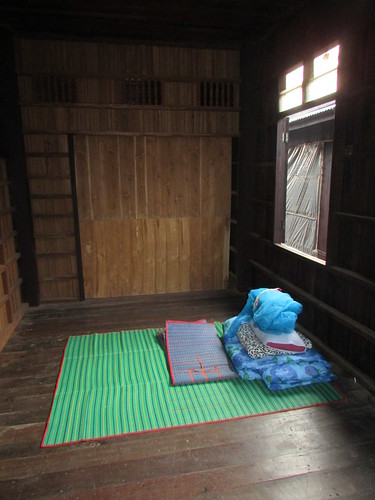
Ko Dut - 2017: My bedroom, with the blue mosquito net awaiting deploymemt.
Helpers from the Drop In Centre rigged my mosquito net (a skill I've never had to acquire) and, after a friendly evening meal, I tried to backup my pictures before the electricity went off. In Ko Dut, a generator at the monastery provides power from 4.00 a.m. to 6.00 a.m. and from 4.00 p.m. to 10.30 p.m.
It was not a very quiet evening. Apparently, the monastery was conducting an appeal for funds to support the new intake of novices. The villagers were reminded of this appeal by continuously playing a loud, penetrating drumbeat. This 'music' was, I think, coming from one or more 'Wall of Sound' installations I'd spotted in various locations (but failed to photograph). Most eating establishments have at least one modern amplifier/loudspeaker arrangement in a rectangular box with impressive-looking loudspeakers. In the 'Wall of Sound' quite a few of these boxes, of various types and in different sizes, are bolted together to form a 'wall' at least eight feet square of fearsome appearance and producing deafening sound.
I didn't sleep particularly well on the hard floor in any case but, around 4.00 a.m. on Monday, the drumbeat started up again, alternating with modern Myanmar vocals.
Related Posts on this Website
Next Post describing this trip.
All 2017 Trip posts.
My Pictures
Where necessary, clicking on an image above will display an 'uncropped' view or, alternately, pictures from may be selected, viewed or downloaded, in various sizes, from the albums listed:-
Trip to Myaw Tit Pagoda.
Returning North.
La Mine Drop In Centre - 2017.
Around Ko Dut.
All my albums for Burma 2017.
[Links to pictures added: 2-May-2017, pictures added to post 19-Jun-2017]
Events of Saturday 22nd April 2017
Before 7.00 a.m., the people carrier had dropped us and our luggage at the house of the Doctor's relative who had accompanied us.

A street scene in Dawei.
A walk to the nearby market was decided upon. The range of fruit, vegetables, fish and meat on offer in Myanmar never ceases to amaze me, although the conditions would probably cause a European food inspector to expire on the spot.
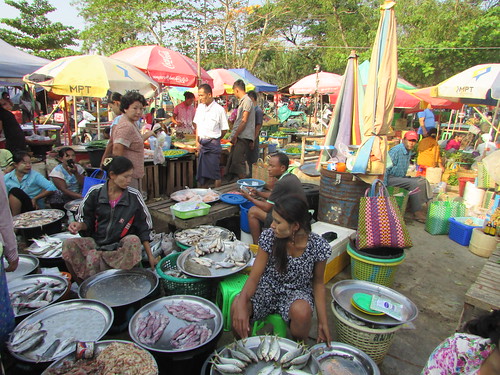
Around Dawei: Dawei Market.
After our market tour, we stopped at one of the Tea Houses that are such a feature of Myanmar life, where we took breakfast. By the time we returned to the house, a Toyota saloon and driver had appeared. With the Dawei relative acting as our guide, we set off to see a little of Dawei.
Our first visit was to a famous wooden Buddhist pagoda with a natural spring believed to have health giving properties.

Around Dawei: Visiting a local pagoda.
Another Buddhist pagoda of wooden construction featured a series of old paintings depicting scenes from the Life of Buddha.

Around Dawei: Visiting second pagoda.
Up in the hills, we visited a large, reclining Buddha image, protected from the weather (as at similar sites) by a huge steel framework supporting a massive roof.
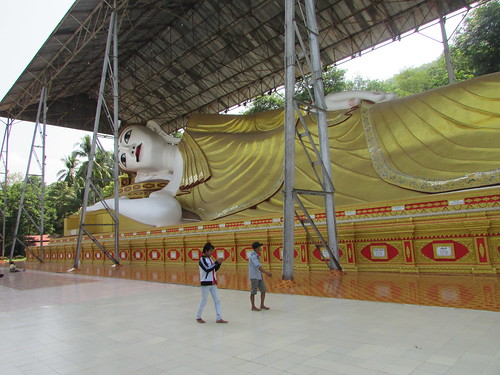
Around Dawei: Reclining Buddha image.
Various 'flavours' of the Baptist Church remain active in Myanmar. We visited the Karen Baptist Church, founded in 1922 and dedicated as a memorial to Marion Sutton.
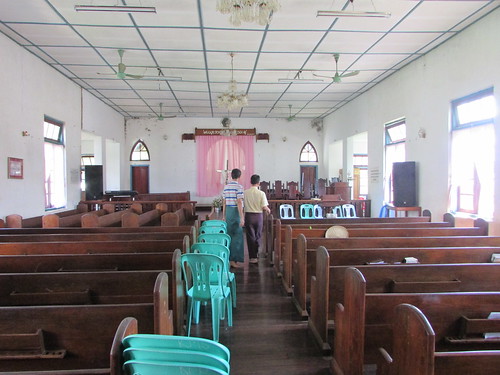
Karen Baptist Church, Dawei.
We paused at a large British Colonial style building now serving as Dawei Education College. Whilst schools were currently on their summer break, the college grounds were crowded with teachers undertaking training.

Dawei Education College.
Finally, we visited perhaps the most famous Buddhist complex in the area at Pha Yar Gyi, including the Shwe Taung Sar Pagoda. There's a website here.

Shwe Taung Sar Pagoda.
Back in the town centre, we took lunch at the Daw San Family Rice and Curry Shop. The food and service was excellent but I was fascinated that a traditional wooden building is in course of being rebuilt into a reinforced concrete structure, with all sorts of trip and other hazards whilst this work proceeds.
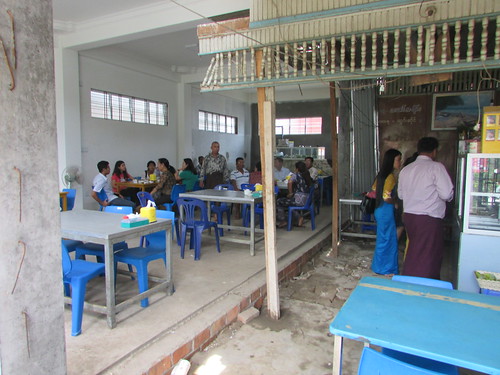
Around Dawei: Daw San Family Rice and Curry Shop (new construction on left, old on right).
I discovered that we were to spend the weekend at wooden beach cottages at Maung Makan Beach so, with our luggage transferred to the Toyota, we set off through the hills to reach the beach, a beautiful white sand expanse fringed with palm trees. But also quite popular with day trippers, as attested by the number of stalls and beach restaurants we passed on an exploratory walk.
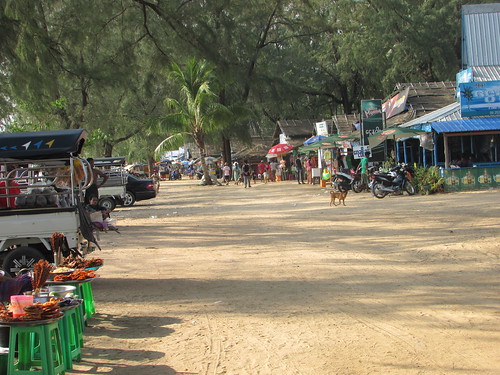
Maungmakan Beach.
We occupied two of the four or five cottages which had been erected on a private strip of land and I was allocated my own cottage. It was a lovely spot but, although my cottage had a raised bed, the plywood base with a thin sleeping mat on top was, shall I say, rather firm for my taste.

Maungmakan Beach: I was given the cottage in the background to myself.
I managed a paddle in the ocean on Saturday evening but Dr. Hla Tun and his Dawei relative had a lengthy swim. Later, we all had dinner at a beach restaurant near our cottages. Fish was on the menu!
Related Posts on this Website
Next post describing the 2017 Burma trip.
All 2017 Trip posts.
My Pictures
Where necessary, clicking on an image above will display an 'uncropped' view or, alternately, pictures may be selected, viewed or downloaded, in various sizes, from the albums listed:-
Around Dawei.
Maungmakan Beach.
All my albums for Burma 2017.
[Minor additions: 1-May-2017, Links to pictures added 2-May-2017, Pictures added 12/13-Jun-2017]
More of Friday 21st April 2017
We actually left Doctor Hla Tun's home at 3.45 p.m. In the car were the Doctor, his elderly mother, his relative from Dawei (who had made the local arrangements), the writer and his elder son (to return the car having dropped us off).
In fairly-heavy traffic, it took us about 45 minutes to drive across Yangon to the Highway Bus Terminal situated in the east of the city. Here, all was the usual chaos as cars, taxis, motor cycles and the trunk coaches themselves vied for space to enter or leave through one of four Gates. Somehow, we found our bus and unloaded our luggage and a couple of large cartons of goods to be donated when we arrived in Mon State.
 Doctor Hla Tun and his Mother with some of our luggage prior to boarding the coach.
Doctor Hla Tun and his Mother with some of our luggage prior to boarding the coach.
The bus was a huge, modern Scania painted white but with most of the bodywork (and windows) disfigured by computer-printed self-adhesive decals in the modern way. The text was in a mixture of English and Myanmar characters. However, our vehicle was an example of restrained good taste in self-advertising, compared with some of the others. Like all buses in Myanmar, ours came with a Driver and Driver's Assistant. The assistant, a wiry youth with 'two-tone' dyed hair in the fashion currently adopted by many young men in Myanmar, was stowing passengers' luggage in the large hold of the bus under the instructions of a third member of the team, a dark-haired young man whose status was indicated by his coach company shirt with epaulettes, a name badge and a clip board with a passenger seating plan for the journey. The Doctor had arranged two adjacent seats for me, for which I was grateful. The seating pitch was certainly suited better to the oriental frame rather than my larger, European build.
To my surprise, at five p.m., the advertised departure time, the bus started to extricate itself from the loading point and enter the throng of traffic entering and leaving the bus terminal. After ten minutes of stuttering progress, we were headed east on the dual carriageway out of Yangon.
Then, we suddenly turned right onto a suburban street and the explanation was soon apparent as we turned into a yard used by our bus company with a number of similar buses (and a few less-distinguished) being prepared for future journeys. The yard area had once had a roof of green, woven-plastic matting suspended from a system of overhead cables which had long-since been shredded by the wind, leaving an erratic series of streamers looking like tattered flags. A group of about eight young men workers started carrying large plastic containers, two at a time, to our bus, stowing them in our luggage hold. We took on thirty of these containers, apparently full of diesel fuel. I noticed that a small plastic bag had been laid across the filler of each container before screwing-on the cap, apparently to 'seal' the threads and prevent loss of fuel in transit.
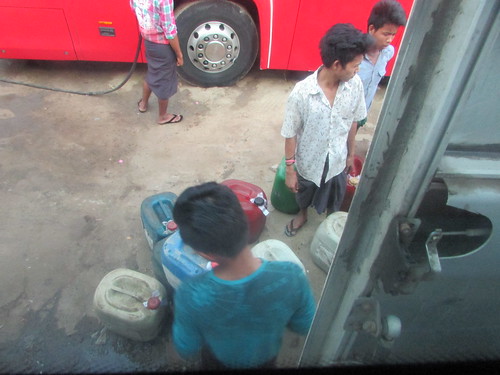 By Coach to Dawei: Loading plastic containers of diesel fuel.
By Coach to Dawei: Loading plastic containers of diesel fuel.
After a few minutes, this unexpected operation was complete and the coach made its way back to the dual carriageway which then turned into a modern highway with an excellent surface towards Bago, along which we made good speed. All too soon, we were back on single carriageway roads where speed dropped but these Highway Buses are driven quite aggressively to maintain their schedules.
As we continued east and then south, darkness descended and the approaching headlights became quite blinding. Our driver didn't see any need to slacken speed, even when overtaking on the wrong side of the road.
I knew from previous trips that there was a major restaurant stop for coaches near Kyaikto and, after around three hours travelling, we stopped for 30 minutes so that passengers could answer the call of nature or take food. With everybody collected back onto the bus, we continued our long journey. We dropped a couple of passengers off at a roundabout on the approach to Mawlamyine and were well south into the mountains before we made another refreshment stop.

By coach to Dawei: Refreshment stop in the mountains.
The road became quite exciting: narrow and twisting and, of course, we met large vehicles heading north at the most inconvenient locations. Nor was this the only challenge. The route was receiving major roadworks to improve and widen the carriageway so at times we were travelling on a temporary surface of rolled stone before tarmac was applied.
I rather lost track of time on this seemingly interminable journey and managed only short periods of sleep. When we stopped again and alighted from the bus, I was initially puzzled because I could see no hint of a restaurant. Then I spotted a sign saying (in English and Myanmar language) "Welcome to Tanintharyi Division". The degree of independence some areas of Myanmar have been given means that immigration checks may be provided, as here moving from Mon State to Tanintharyi. Local people offer their Identity Card for inspection, whilst foreigners submit their passport, to have the details solemnly entered in a log book. The check seemed friendly enough but it was odd to be part of a stream of pedestrians walking across the border in the middle of the night, crossing a similar stream heading in the opposite direction. We then had to wait at the roadside until our bus caught up with us, having been let through a single lane barrier.
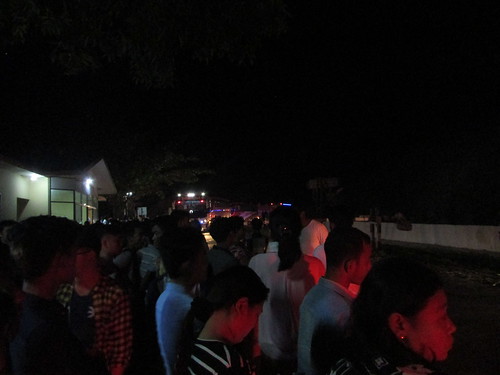
By Coach to Dawei: Waiting for our coach at the immigration station.
The major road works continued after the border crossing and our final stop was at a restaurant high in the mountains shrouded in mist, although it was still warm enough to walk around without a jacket.
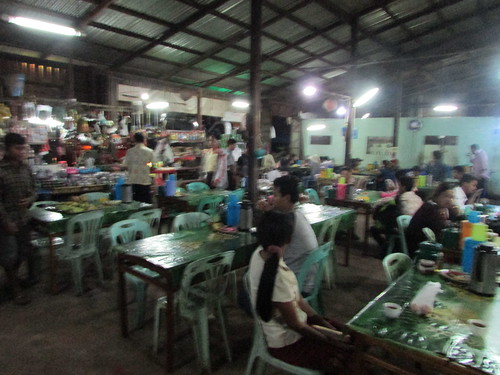
By Coach to Dawei: Our final refreshment stop.
Then, the sky lightened and by the time we arrived at Dawei Bus Station, it was fully light after our marathon of more than thirteen hours. The expected chaos reigned but, somehow, our luggage was extracted and we were seated in a people carrier with some complete strangers on a sort of shared taxi arrangement which took us into the town.
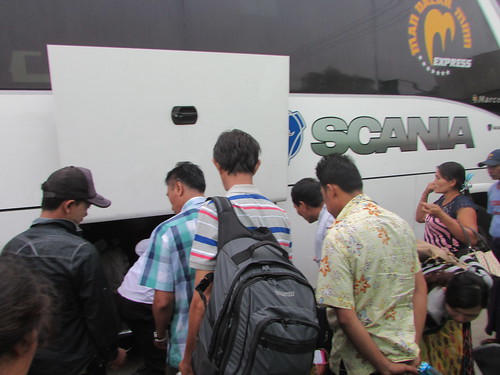
By Coach to Dawei: Arrival at Dawei Bus Station.
Related Posts on this Website
Next 2017 Trip post.
All 2017 Trip posts.
My Pictures
Where necessary, clicking on an image above will display an 'uncropped' view or, alternately, pictures from may be selected, viewed or downloaded, in various sizes, from the album listed:-
By Coach to Dawei.
All my albums for Burma 2017.
[Pictures added: 2-May-2017, 6-Jun-2017]
Events of Friday 21st April 2017
Breakfast was taken at 7.00 a.m. Doctor Hla Tun had planned for us to set off by coach in the afternoon, on the long journey to Dawei, in the south of Myanmar, some 600 km from Yangon. Accordingly, I thought it might be prudent to have a restful morning at the Doctor's house, working on the computer and trying to compress enough changes of clothes for the trip into a small rucksack, which I attempted without conspicuous success. I was summoned to lunch at around 11.15 a.m., a time when at home I would be thinking about a morning cup of tea! Various departure times were mooted, which finally settled at 3.15 p.m. and I tried to prepare myself for another long journey.
Related Posts on this Website
Next 2017 trip post.
All 2017 Burma Trip posts.
My Pictures
Pictures from may be selected, viewed or downloaded, in various sizes, from the collection listed:-
All my albums for Burma 2017.
Events of Thursday 20th April 2017
Emirates gave me an excellent journey to Yangon, both in the air and on the ground. Emirates operate a 'hub' structure, so the first flight was Birmingham - Dubai, followed by a Dubai - Yangon 'leg', both operated by Boeing 777-300ER. The flight to Yangon was then going on to Hanoi. We were a few minutes early arriving in Yangon, using the new section of terminal which had still been under construction on my last trip. Formalities were quickly completed, my luggage arrived promptly and my host, Doctor Hla Tun, was waiting for me. We drove through fairly heavy traffic to the Doctor's home where I was made very welcome.
Lunch was the usual friendly affair, with my food and portion sizes adapted to my preferences, as discovered by my hosts during my previous visits. But, however much I eat, there is always encouragement to have an extra portion, or try an extra item. The legendary hospitality of the people of Myanmar has not been exaggerated.
It's become a ritual that I travel on Yangon's Circle Line suburban railway on my visits and I decided that, despite being fairly tired after the long trip from England, I would make a railway trip in the afternoon since, the following day, we would be setting off by coach to the south of Myanmar. The Doctor insisted on taking me to Yangon Central Station and making arrangements for my return to his home. Over the years, I've used clockwise Circle Line trains more often than anti-clockwise, so I decided to wait for the next anti-clockwise service. The wait was longer than planned but there's always train movements around the station worth watching.

Yangon's Circle and Suburban Lines.
A major project has started under which Japan will modernise the Circle Line and I was eager to look for visible signs of this work and record the earlier methods of working before it changes.
When my train arrived, I was pleased that it was locomotive-hauled stock, with one of the elderly, hard-working 900 h.p. Bo-Bo locomotives at the front (I failed to get the number, sorry). Circle Line trains were formerly all locomotive-hauled but, as I've documented in earlier posts, second-hand Japanese Diesel Multiple Units now share the work. Late afternoon, we were well into the rush hour and there were lots of standing passengers.
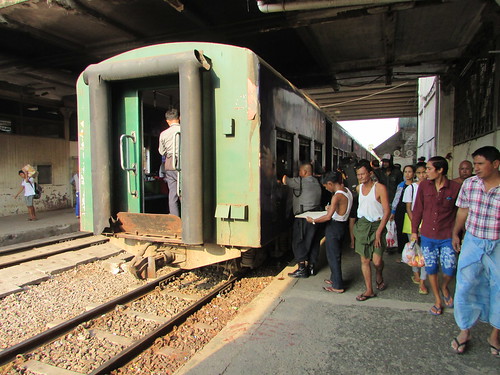
Circle Line - 2017: Yangon Central Station.
It didn't seem to discourage the food and drink hawkers who work their way up and down trains, noisily shouting their services. Air temperature was in the mid- to high-thirties and there's no air conditioning on these old passenger coaches (often no continuous brake, either) so electric fans mounted on the coach ceiling did their best to stir up the air and all sliding windows were kept permanently open. Although I found plenty of interest in studying the railway infrastructure, 'people-watching' can also be undertaken. I think that my first trip on Yangon's Circle Line in 2008 helped to lead to my fascination with Myanmar and its wonderful people. It's certainly rather different from London's Circle Line!
It was dark by the time I returned to the Doctor's house after my rail trip. I was very tired and retired to bed early.
Related Posts on this Website
Next 2017 Trip post.
All 2017 Trip posts.
There are a number of posts describing Myanma Railways and my previous trips on the Circle Line. You can find them all here.
There's a brief introduction to railway diesel traction in Myanmar, and the various classes in use, here.
My Pictures
Where necessary, clicking on an image above will display an 'uncropped' view or, alternately, pictures may be selected, viewed or downloaded, in various sizes, from the album listed:-
Circle Line - 2017.
All my pictures of Myanma Railways and the Circle Line can be found here (photographs can be selected, viewed or downloaded, in various sizes).
[Pictures added 2-May-2017]
I send this short report from the Emirates Lounge at Birmingham Airport, prior to boarding the afternoon flight to Dubai with an onwards connection to Yangon (which the British used to call 'Rangoon').
Regular readers will be aware that I have established a pattern of an annual visit to Myanmar (as we should now call what was once 'Burma'). On my first visit in 2008, the people and the location captured my heart and I became involved in supporting, in a small way, charitable initiatives there. Initially, these initiatives were concerned with education, helping to build new schoolrooms and contributing to the running costs of schools. This work continues but, in 2011, a long-held ambition of Doctor Hla Tun and the Abbott of Bagan Monastery was fulfilled with the opening of Bagan Medical Clinic to provide medical care to poor people. Although intended purely as a local clinic for the Bagan area, its fame has resulted in patients travelling large distances - even 200 and 300 miles - to receive treatment. This success has attracted both local and overseas donors, allowing additional buildings to be constructed accommodating different facilities so that the site is becoming more hospital than simply 'clinic'.
So, it is with some excitement that I set off from England on a journey which will re-unite me with friends in Burma, take me to a number of educational and support organisations receiving charitable donations and spend a few days closely studying the work of the Bagan Medical Clinic. In addition, I intend to make a 'side trip' to an area of Myanmar I've not previously visited. I'll also spend a little time looking at the railway system, still antiquated but with initiatives in hand to upgrade the network.
My 2017 Trip
As I am able, I will add posts describing my progress but the format of the journey will be similar to that in previous years (such as Burma-2016, Burma-2015).
Next 2017 Trip post.
All 2017 Trip posts.
You can find all my posts on Education Support in Burma here and those on Medical Support here.
My Pictures
Pctures from may be selected, viewed or downloaded, in various sizes, from the collection listed:-
All my albums for Burma 2017.
This report is based on information received from Doctor Hla Tun on 14-Jul-2016 and 20-Oct-2016 and 12-Jan-2017. He also supplied the photographs. The delay in posting this report is, I'm afraid, down to me.
My previous report showed monthly statistics up to the end of March, 2016, when the total number of treatments since the Clinic opened on August 6, 2011 was 169,211.
Treatment Summary
The table below summarises the number of treatments per month from April 2016 to December 2016 and the total number of treatments.
| Month |
Treatments in month |
Total treatments |
| April 2016 |
1,243 |
170,454 |
| May 2016 |
1,676 |
172,130 |
| June 2016 |
1,812 |
173,972 |
| July 2016 |
2,958 |
176,930 |
| August 2016 |
2,416 |
179,346 |
| September 2016 |
3,366 |
182,712 |
| October 2016 |
3,096 |
185,808 |
| November 2016 |
1,989 |
187,797 |
| December 2016 |
2,233 |
190,030 |
Bagan Medical Clinic Opening
The Bagan Medical Clinic is open throughout the year except for one or two weeks during April because of the Water Festival and Myanmar New Year.
Doctor Hla Tun is also Chief Medical Officer aboard the 'Road to Mandalay' river cruise ship operated by Belmond. During much of the season, this ship shuttles between Shwe Kyet Yet (near Mandalay) and Bagan, mooring at Bagan (close to the Bagan Clinic) from Friday to Monday, whilst the ship's guests explore the wonders of the pagodas spread across the Bagan Plain. This allows Doctor Hla Tun to open the Bagan Clinic on Friday, Saturday and Sunday. Working from 08:30 to 23:00 (with short breaks for food) Doctor Hla Tun typically sees 90 patients each day the Clinic is open. Less complex cases are seen by other doctors.
Free Lunches
A free lunch is served to patients and their companions on the clinic days (Friday, Saturday, Sunday).
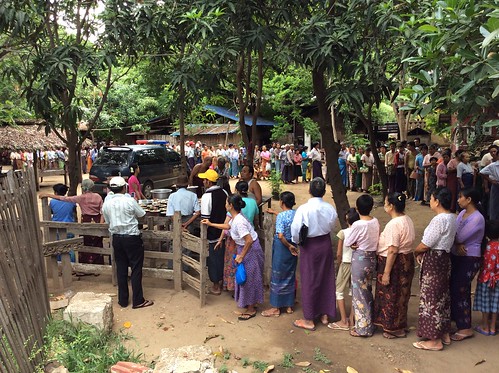
Free lunch being served to patients and their companions.
Donation of Children's Clothing
Donations of children's clothing are occasionally made to young patients.
Donation of Reading Glasses to elderly patients
Donations of Reading Glasses are occasionally made to elderly patients.
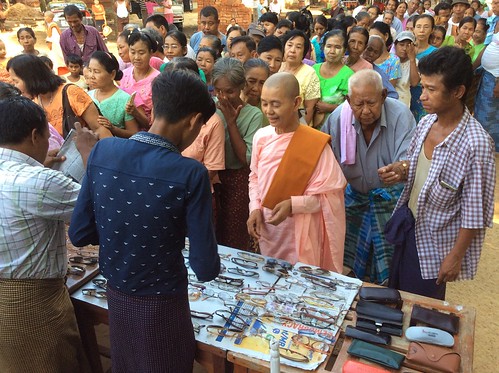
Bagan Clinic 2016: Distribution of reading glasses to elderly patients.
Health education talks
Health education talks are occasionally given to patients in the clinic by Doctor Hla Tun.
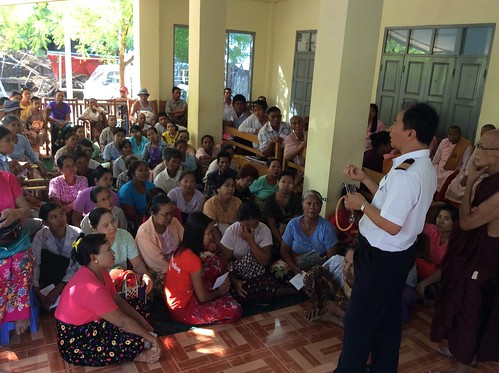
Doctor Hla Tun giving health education advice to patients at the clinic.
br>
Need for translators
Some patients travel long distances from the Delta, Rakhine State and Chin State to the Clinic. Translators are required for some of these ethnic groups because of the local dialects they use rather than standard Myanmar language.
Chin State, in Western Myanmar, is close to the Indian border and a patient from that area required a translator, as she couldn't understand the Myanmar language. This patient had facial tattoos, once common in the area.

Patient from Chin State with facial tattoos.
New Equipment for Bagan Clinic
In May 2016, the generosity of two Guests funded the purchase of a new dental chair.

Bagan Clinic, May 2016: New Dental Chair.
Opening of Two Storey Clinic Building
Donors have provided funds for a 2-storey clinic building at the Bagan Clinic.

2-storey building under construction.
On 23rd September 2016, the two storey clinic building was opened. It includes rooms for a Dental Surgery, Eye Clinic, X-Ray Machine, UltraSound Machine, two Operating Theatres (one for eye surgery, one for general surgery) and two rooms to accommodate visiting doctors.

Opening of Two Storey Clinic Building
The opening was celebrated by a concert given by students.
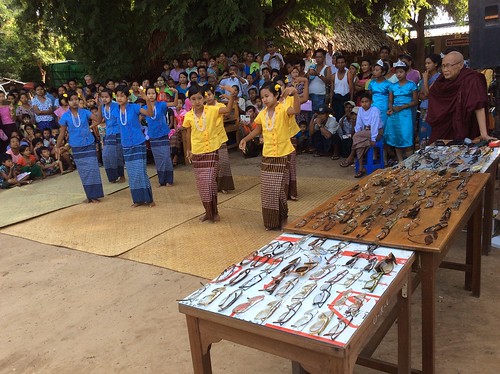
Opening of Two Storey Clinic Building, concert by students.
Individual Patient Stories
A lady who suffered from drooping of her upper eyelids could not afford to buy medicine and so she used tape or plaster between forehead and eyebrow at one end and upper eye lid at the other end to open her eyes. She was treated with eye drops.

Patient with drooping eyelids.
A boy with muscle weakness on his right side improved his condition after medicine and physical exercise. He showed that he could kick a football.
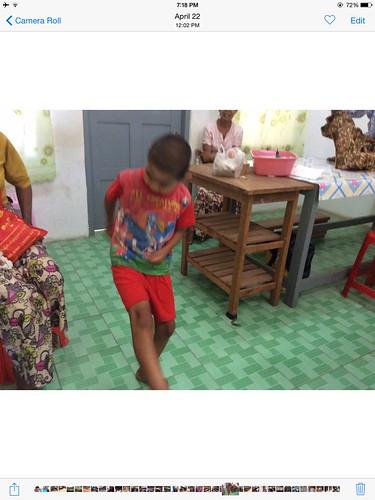
Young boy's improved condition after treatment.
In the previous update on Bagan Clinic here, we reported donations of anti-snake venom to hospitals. A particularly tragic case involving a snake bite concerns a lady from Chauk who earns a living collecting plums from under trees. Whilst collecting plums from a hole in the ground, she was bitten by a cobra. The local hospital injected anti-snake venom then she continued treatment with traditional medicine but developed a necrotic ulcer with exposed bone. Relatives and friends gave her money for transportation to Magway Divisional Hospital (about four hours away) for wound debridement treatment but she could not afford the transport costs for the necessary 3 or 4 follow-up treatments. Instead, she attended Bagan Medical Clinic where the cost of transport for further treatment at Magway (the equivalent of 8 Dollars U.S. per trip) was donated.

After-effects of a snake bite.
A 93 year old lady from SeikPhyu (about 60 miles from Bagan clinic) received supportive treatment and a donation of her transportation
fee and accommodation cost to allow her to receive treatment in Magway Divisional Hospital.
Patients with joint stiffness and pain can be helped by electrical stimulation of nerve and muscle and the use of a traction machine.
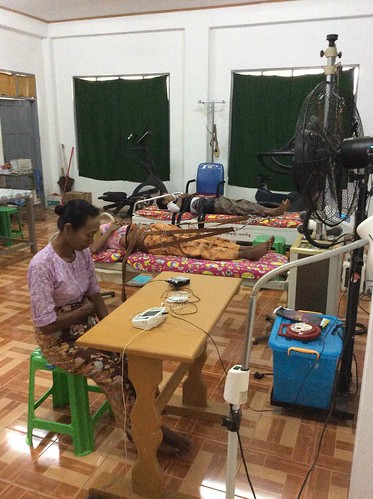
Electrical stimulation and traction treatment.
Special Medical Clinic Opening
On Monday, 26th September 2016 the 'Road to Mandalay' ship was 'stopped' at Bagan for a week, giving the Doctor the opportunity to open the clinic for a whole week. On the evening of Sunday 25th September, there were still some 350 patients waiting at the Clinic. Appointments were made for these waiting patients to return on a specific day to receive treatment. Patients who had travelled long distances were temporarily accommodated in the Bagan Monastery or at nearby monasteries. The Bagan Monastery was able to provide a free lunch every day and at least one free breakfast and one free dinner but patients accommodated elsewhere had to buy breakfast, lunch and dinner each day for up to five days, adding to the cost of their visit.
One couple from a remote area had borrowed money for food whilst waiting against the security of their gold ring but, when Doctor Hla Tun discovered this, he gave them the money to recover their ring.
Depending upon the distance travelled to reach the Clinic, transport can cost the equivalent of 5 - 20 Dollars U.S. per person and it's common to hear of a pig, goat, chicken or duck being sold to pay for transport.
During this week, Doctor Hla Tun asked a group of old ladies, who waited four days for treatment, why they had not gone back to their village about 50 miles away and returned on the day of the appointment. Their answer was that, once they'd paid to go home, they would be left with no money to return to the Clinic. Most of the group suffered from joint pain but the waiting additionally produced colds and coughs.
Other reports on medical support in Myanmar
There are a number of posts in this Blog describing medical support in Myanmar provided by the RTM Social Contribution with help from donors around the world. You can find them all here.
Photographs
There's a collection of pictures showing the Bagan Clinic from its inception here.
Doctor Hla Tun's photographs showing the work of the Bagan Clinic can be accessed by the following links:-
2014
2015
2016





















































